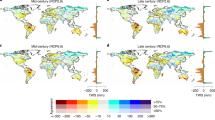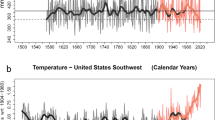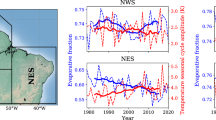Abstract
Changes in evapotranspiration (ET) affect water availability and ecosystem health. Higher evaporative demand during drought acts to increase ET, but droughts also reduce the moisture supply necessary for ET, limiting predictions of even the sign of ET anomalies. Drought-driven increases in ET (\({\rm{ET}}_{{\rm{drought}}}^ +\)) are of particular concern because they quickly deplete water resources, causing flash droughts and acute stress on ecosystems. Here, using a water balance approach, we show that \({\rm{ET}}_{{\rm{drought}}}^ +\) is globally widespread, occurring in 44.4% of drought months. The sign of ET’s drought response depends most on the magnitude of precipitation and total water storage anomalies, rather than its location. The Coupled Model Intercomparison Project Phase 6 Earth system models underestimate the \({\rm{ET}}_{{\rm{drought}}}^ +\) probability by nearly one-half, and more so in drier regions, primarily due to missing representations of soil structure effects on soil evaporation, as well as incorrectly parameterized plant and soil traits. These processes should be prioritized to reduce model uncertainties in the water–energy–food nexus.
This is a preview of subscription content, access via your institution
Access options
Access Nature and 54 other Nature Portfolio journals
Get Nature+, our best-value online-access subscription
$29.99 / 30 days
cancel any time
Subscribe to this journal
Receive 12 print issues and online access
$209.00 per year
only $17.42 per issue
Buy this article
- Purchase on Springer Link
- Instant access to full article PDF
Prices may be subject to local taxes which are calculated during checkout




Similar content being viewed by others
Data availability
GRACE and GRACE-FO TWS data are available from the NASA JPL (https://grace.jpl.nasa.gov/data/get-data/jpl_global_mascons/). The GPCP version 2.3 combined precipitation dataset is available at https://psl.noaa.gov/data/gridded/data.gpcp.html. ERA5 reanalysis is available at https://www.ecmwf.int/en/forecasts/datasets/reanalysis-datasets/era5. MODIS LAI data are available at https://lpdaac.usgs.gov/products/mcd15a3hv006/. MODIS land cover data are available at https://lpdaac.usgs.gov/products/mcd12c1v006/. Runoff data are available at https://www.bafg.de/GRDC. CMIP6 model outputs are available at https://esgf-node.llnl.gov/projects/cmip6/. The FLUXNET2015 dataset is available at https://fluxnet.org/data/fluxnet2015-dataset/. Elevation data are available at https://neo.gsfc.nasa.gov/view.php?datasetId=SRTM_RAMP2_TOPO. Ecosystem rooting depth data are available at https://wci.earth2observe.eu/thredds/catalog/usc/root-depth/catalog.html. Groundwater table depth data are available at http://thredds-gfnl.usc.es/thredds/catalog/GLOBALWTDFTP/catalog.html. The data necessary to reproduce the main results are provided at https://doi.org/10.5281/zenodo.6842054 (ref. 61).
Code availability
The computer code necessary to reproduce the main results is provided at https://doi.org/10.5281/zenodo.6842054 (ref. 61).
References
Ault, T. R. On the essentials of drought in a changing climate. Science 368, 256–260 (2020).
Rodell, M. et al. Emerging trends in global freshwater availability. Nature 557, 651–659 (2018).
Green, J. K. et al. Large influence of soil moisture on long-term terrestrial carbon uptake. Nature 565, 476–479 (2019).
Reichstein, M. et al. Climate extremes and the carbon cycle. Nature 500, 287–295 (2013).
Goulden, M. L. & Bales, R. C. California forest die-off linked to multi-year deep soil drying in 2012–2015 drought. Nat. Geosci. 12, 632–637 (2019).
Brodribb, T. J., Powers, J., Cochard, H. & Choat, B. Hanging by a thread? Forests and drought. Science 368, 261–266 (2020).
Seneviratne, S. I. et al. Investigating soil moisture–climate interactions in a changing climate: a review. Earth Sci. Rev. 99, 125–161 (2010).
Short Gianotti, D. J., Rigden, A. J., Salvucci, G. D. & Entekhabi, D. Satellite and station observations demonstrate water availability’s effect on continental-scale evaporative and photosynthetic land surface dynamics. Water Resour. Res. 55, 540–554 (2019).
Anderegg, W. R. L., Trugman, A. T., Bowling, D. R., Salvucci, G. & Tuttle, S. E. Plant functional traits and climate influence drought intensification and land–atmosphere feedbacks. Proc. Natl Acad. Sci. USA 116, 14071–14076 (2019).
Jung, M. et al. Recent decline in the global land evapotranspiration trend due to limited moisture supply. Nature 467, 951–954 (2010).
Novick, K. A. et al. The increasing importance of atmospheric demand for ecosystem water and carbon fluxes. Nat. Clim. Chang. 6, 1023–1027 (2016).
Liu, Y., Kumar, M., Katul, G. G., Feng, X. & Konings, A. G. Plant hydraulics accentuates the effect of atmospheric moisture stress on transpiration. Nat. Clim. Chang. 10, 691–695 (2020).
Gupta, A., Rico-Medina, A. & Caño-Delgado, A. I. The physiology of plant responses to drought. Science 368, 266–269 (2020).
Wolf, S. et al. Warm spring reduced carbon cycle impact of the 2012 US summer drought. Proc. Natl Acad. Sci. USA 113, 5880–5885 (2016).
Teuling, A. J. et al. Evapotranspiration amplifies European summer drought. Geophys. Res. Lett. 40, 2071–2075 (2013).
Mastrotheodoros, T. et al. More green and less blue water in the Alps during warmer summers. Nat. Clim. Chang. 10, 155–161 (2020).
Peterson, T. J., Saft, M., Peel, M. C. & John, A. Watersheds may not recover from drought. Science 372, 745–749 (2021).
Helbig, M. et al. Increasing contribution of peatlands to boreal evapotranspiration in a warming climate. Nat. Clim. Chang. 10, 555–560 (2020).
Massmann, A., Gentine, P. & Lin, C. When does vapor pressure deficit drive or reduce evapotranspiration? J. Adv. Model. Earth Syst. 11, 3305–3320 (2019).
Grossiord, C. et al. Plant responses to rising vapor pressure deficit. New Phytol. 226, 1550–1566 (2020).
Orth, R. & Destouni, G. Drought reduces blue-water fluxes more strongly than green-water fluxes in Europe. Nat. Commun. 9, 3602 (2018).
Pendergrass, A. G. et al. Flash droughts present a new challenge for subseasonal-to-seasonal prediction. Nat. Clim. Chang. 10, 191–199 (2020).
Chu, H., Baldocchi, D. D., John, R., Wolf, S. & Reichstein, M. Fluxes all of the time? A primer on the temporal representativeness of FLUXNET. J. Geophys. Res. Biogeosci. 122, 289–307 (2017).
Ukkola, A. M. et al. Land surface models systematically overestimate the intensity, duration and magnitude of seasonal-scale evaporative droughts. Environ. Res. Lett. 11, 104012 (2016).
Trugman, A. T., Medvigy, D., Mankin, J. S. & Anderegg, W. R. L. Soil moisture stress as a major driver of carbon cycle uncertainty. Geophys. Res. Lett. 45, 6495–6503 (2018).
De Kauwe, M. G. et al. Do land surface models need to include differential plant species responses to drought? Examining model predictions across a mesic–xeric gradient in Europe. Biogeosciences 12, 7503–7518 (2015).
Dong, J., Lei, F. & Crow, W. T. Land transpiration–evaporation partitioning errors responsible for modeled summertime warm bias in the central United States. Nat. Commun. 13, 336 (2022).
Kennedy, D. et al. Implementing plant hydraulics in the Community Land Model, version 5. J. Adv. Model. Earth Syst. 11, 485–513 (2019).
Novick, K. A. et al. Confronting the water potential information gap. Nat. Geosci. 15, 158–164 (2022).
Liu, Y., Holtzman, N. M. & Konings, A. G. Global ecosystem-scale plant hydraulic traits retrieved using model–data fusion. Hydrol. Earth Syst. Sci. 25, 2399–2417 (2021).
Lin, Y.-S. et al. Optimal stomatal behaviour around the world. Nat. Clim. Chang. 5, 459–464 (2015).
Fan, Y., Miguez-Macho, G., Jobbágy, E. G., Jackson, R. B. & Otero-Casal, C. Hydrologic regulation of plant rooting depth. Proc. Natl Acad. Sci. USA 114, 10572–10577 (2017).
Anderegg, W. R. L. et al. Hydraulic diversity of forests regulates ecosystem resilience during drought. Nature 561, 538–541 (2018).
Lehmann, P., Merlin, O., Gentine, P. & Or, D. Soil texture effects on surface resistance to bare-soil evaporation. Geophys. Res. Lett. 45, 10398–10405 (2018).
Fatichi, S. et al. Soil structure is an important omission in Earth System Models. Nat. Commun. 11, 522 (2020).
McCormick, E. L. et al. Widespread woody plant use of water stored in bedrock. Nature 597, 225–229 (2021).
Baldocchi, D., Ma, S. & Verfaillie, J. On the inter- and intra-annual variability of ecosystem evapotranspiration and water use efficiency of an oak savanna and annual grassland subjected to booms and busts in rainfall. Glob. Chang. Biol. 27, 359–375 (2021).
Condon, L. E., Atchley, A. L. & Maxwell, R. M. Evapotranspiration depletes groundwater under warming over the contiguous United States. Nat. Commun. 11, 873 (2020).
Maxwell, R. M. & Condon, L. E. Connections between groundwater flow and transpiration partitioning. Science 353, 377–380 (2016).
Humphrey, V. et al. Sensitivity of atmospheric CO2 growth rate to observed changes in terrestrial water storage. Nature 560, 628–631 (2018).
Mankin, J. S., Seager, R., Smerdon, J. E., Cook, B. I. & Williams, A. P. Mid-latitude freshwater availability reduced by projected vegetation responses to climate change. Nat. Geosci. 12, 983–988 (2019).
Strassburg, B. B. N. et al. Global priority areas for ecosystem restoration. Nature 586, 724–729 (2020).
Zhao, M. et al. Ecological restoration impact on total terrestrial water storage. Nat. Sustain. 4, 56–62 (2021).
Feng, X. et al. Revegetation in China’s Loess Plateau is approaching sustainable water resource limits. Nat. Clim. Chang. 6, 1019–1022 (2016).
Guan, K. et al. Photosynthetic seasonality of global tropical forests constrained by hydroclimate. Nat. Geosci. 8, 284–289 (2015).
Fan, Y., Li, H. & Miguez-Macho, G. Global patterns of groundwater table depth. Science 339, 940–943 (2013).
Zhao, M., Geruo, A., Velicogna, I. & Kimball, J. S. A global gridded dataset of GRACE drought severity index for 2002–14: comparison with PDSI and SPEI and a case study of the Australia Millennium Drought. J. Hydrometeorol. 18, 2117–2129 (2017).
Watkins, M. M., Wiese, D. N., Yuan, D.-N., Boening, C. & Landerer, F. W. Improved methods for observing Earth’s time variable mass distribution with GRACE using spherical cap mascons. J. Geophys. Res. Solid Earth 120, 2648–2671 (2015).
Wiese, D. N., Landerer, F. W. & Watkins, M. M. Quantifying and reducing leakage errors in the JPL RL05M GRACE mascon solution. Water Resour. Res. 52, 7490–7502 (2016).
Adler, R. F. et al. The Version-2 Global Precipitation Climatology Project (GPCP) monthly precipitation analysis (1979–present). J. Hydrometeorol. 4, 1147–1167 (2003).
Sun, Q. et al. A review of global precipitation data sets: data sources, estimation, and intercomparisons. Rev. Geophys. 56, 79–107 (2018).
Gebremichael, M. et al. Error uncertainty analysis of GPCP monthly rainfall products: a data-based simulation study. J. Appl. Meteorol. 42, 1837–1848 (2003).
Rodell, M. et al. Basin scale estimates of evapotranspiration using GRACE and other observations. Geophys. Res. Lett. 31, L20504 (2004).
Major River Basins of the World (Global Runoff Data Centre, 2020).
Pascolini-Campbell, M. A., Reager, J. T. & Fisher, J. B. GRACE-based mass conservation as a validation target for basin-scale evapotranspiration in the contiguous United States. Water Resour. Res. 56, e2019WR026594 (2020).
Fekete, B. M., Vörösmarty, C. J. & Grabs, W. High-resolution fields of global runoff combining observed river discharge and simulated water balances. Global Biogeochem. Cycles 16, 15-1–15-10 (2002).
Breiman, L. Random forests. Mach. Learn. 45, 5–32 (2001).
Myneni, R., Knyazikhin, Y. & Park, T (ed. NASA EOSDIS Land Processes DAAC) (2021).
Hersbach, H. et al. The ERA5 global reanalysis. Q. J. R. Meteorol. Soc. 146, 1999–2049 (2020).
Sulla-Menashe, D. & Friedl, M. A. User Guide to Collection 6 MODIS Land Cover (MCD12Q1 and MCD12C1) Product (US Geological Survey, 2018).
Zhao, M., Aa, G., Liu, Y. & Konings, A. Evapotranspiration frequently increases during droughts. Zenodo https://doi.org/10.5281/zenodo.6842054 (2022).
Acknowledgements
We are grateful to D. Kennedy for helpful comments on the CMIP6 model results. M.Z. and A.G.K. were supported by NASA Terrestrial Ecology award 80NSSC18K0715 through the New Investigator Program and by the NASA Modeling, Analysis, and Prediction program under award 80NSSC21K1523.
Author information
Authors and Affiliations
Contributions
A.G.K. and M.Z. conceived of the study. M.Z. conducted the analyses with A.G.K. and G.A. M.Z. and A.G.K. wrote the initial draft of the manuscript. All authors edited the manuscript.
Corresponding author
Ethics declarations
Competing interests
The authors declare no competing interests.
Peer review
Peer review information
Nature Climate Change thanks Sanaa Hobeichi, Justin Mankin and the other, anonymous, reviewer(s) for their contribution to the peer review of this work.
Additional information
Publisher’s note Springer Nature remains neutral with regard to jurisdictional claims in published maps and institutional affiliations.
Extended data
Extended Data Fig. 1 Number of analyzed drought months for each year.
Number of drought months that are detected using our drought definition for each year during 2003–2020. Basemap from Natural Earth (https://www.naturalearthdata.com/).
Extended Data Fig. 2 The robustness of the runoff assumption.
(a) Spatial distribution of 185 analyzed hydrological basins. Colors in the map differentiate basins. (b) The scatterplot of ET′ (calculated using a complete water balance) and \(P\prime - \frac{{dTWS}}{{dt}}\prime\) across all basin-drought months. The number in squared box represents the count of basin-month points in each quadrant. The accuracy of using the sign of \(P\prime - \frac{{dTWS}}{{dt}}\prime\) to approximate the sign of ET′ is (1030 + 1384)/(1030 + 261 + 1348 + 23) ≈ 0.9. Subplot (c) is like (b) but for basin-drought months with ZET’ > 0.25. (d) Accuracy of each basin’s determination of the sign of ET′ when neglecting runoff in the calculation of ET′. Each point is one of the basins shown in (a). The color of each point represents the average uncertainty of the ET′ estimate, calculated using Eq. (4) of the Methods (the same calculation as performed at the mascon-scale). The vertical line represents the area of a mascon. Basemap from Natural Earth (https://www.naturalearthdata.com/).
Extended Data Fig. 3 The ET anomaly error is dominated by the random error.
The frequency distribution of the ratio between ET’ random error (σET) and ET’ total observational uncertainty (\(\sqrt {\sigma _{{{{\mathrm{ET}}}}}^2 + |{{{\mathrm{R}}}}\prime |^2}\)) for 2662 basin-drought months across 185 hydrological basins with GRDC data. High values of the x-axis suggest that the total error in our water-balance estimate of ET’ is driven primarily by random errors in the ET estimates propagated from uncertainties in input P, \(\frac{{dTWS}}{{dt}}\), and R, rather than the propagated bias derived from systematically neglecting an R′ that has non-zero mean. Thus, high values of the ratio shown on the x-axis justify the assumption to neglect bias from R′ when propagating all error sources to the estimates of ET′.
Extended Data Fig. 4 \(P({\rm{ET}}_{{\rm{drought}}}^ + )\) error.
Standard error of \(P(ET_{drought}^ + )\). Inset shows the probability density function of each location’s \(P(ET_{drought}^ + )\) standard error across the globe. Basemap from Natural Earth (https://www.naturalearthdata.com/).
Extended Data Fig. 5 Ground-level observational analyses of \(P(ET_{drought}^ + )\).
(a) Spatial distribution of the 36 FLUXNET2015 sites used. (b) The frequency distribution of \(P(ET_{drought}^ + )\) of these sites. Basemap from Natural Earth (https://www.naturalearthdata.com/).
Extended Data Fig. 6 Climate of observed and model-simulated drought events.
Kernel density estimate of the joint probability distribution of ZTWS and ZP for our observations and CMIP6 ESMs.
Extended Data Fig. 7 Using PFT-averages for plant traits does not significantly change the distribution of \(P(ET_{drought}^ + )\).
Comparison between the constrained trait model run and the PFT-wide average trait run. Corresponding dots on the x-axis represents the global average value of \(P(ET_{drought}^ + )\) for each estimate.
Extended Data Fig. 8 Soil structure effect on bare-soil evaporation and plant transpiration.
(a–c) The probability of ET, bare-soil evaporation (E), and transpiration (T) increase during droughts as a function of the aridity index, respectively. (d-f) are similar to (a-c) but as a function of the LAImax. We calculated \(P(E_{drought}^ + )\) and \(P\left( {T_{drought}^ + } \right)\) in the same way as \(P(ET_{drought}^ + )\). That is, each is calculated as the number of drought months with positive E (or T) anomalies divided by the total number of drought months at each grid cell.
Extended Data Fig. 9 Drought intensity effect on \({{{\boldsymbol{P}}}}({{{\boldsymbol{ET}}}}_{{{{\boldsymbol{drought}}}}}^ + )\).
The kernel density estimation of \(P(ET_{drought}^ + )\) as a function of drought intensity (ZP and ZTWS).
Extended Data Fig. 10 Variable importance comparison between observations and ESMs.
Normalized variable importance in observation-derived random forests (bars) and ESM-derived random forests (colored dots). Blue color bars represent drought-specific variables and green color bars represent geographic variables. Colored dots follow the same color scheme of main Fig. 2.
Supplementary information
Supplementary Information
Supplementary Tables 1–3 and Fig. 1.
Rights and permissions
Springer Nature or its licensor holds exclusive rights to this article under a publishing agreement with the author(s) or other rightsholder(s); author self-archiving of the accepted manuscript version of this article is solely governed by the terms of such publishing agreement and applicable law.
About this article
Cite this article
Zhao, M., A, G., Liu, Y. et al. Evapotranspiration frequently increases during droughts. Nat. Clim. Chang. 12, 1024–1030 (2022). https://doi.org/10.1038/s41558-022-01505-3
Received:
Accepted:
Published:
Issue Date:
DOI: https://doi.org/10.1038/s41558-022-01505-3
This article is cited by
-
Unravelling the origin of the atmospheric moisture deficit that leads to droughts
Nature Water (2024)
-
Integrating ecosystem water demands into drought monitoring and assessment under climate change
Nature Water (2024)
-
Global ecosystem responses to flash droughts are modulated by background climate and vegetation conditions
Communications Earth & Environment (2024)
-
Contrasting sensitivity of air temperature trends to surface soil temperature trends between climate models and reanalyses
npj Climate and Atmospheric Science (2024)
-
Recent human-induced atmospheric drying across Europe unprecedented in the last 400 years
Nature Geoscience (2024)



